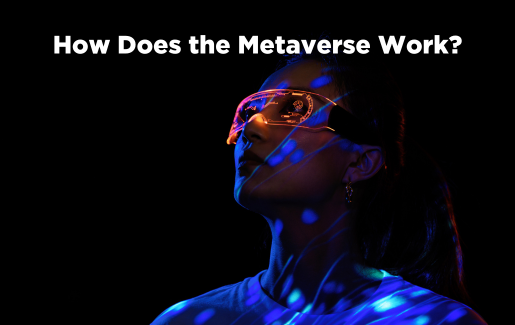 The metaverse has gained significant hype over the last couple of years as the next big thing. The metaverse was a term coined in 1982 in the novel Snow Crash. The text references a digital world where people go to escape a bleak future world. Facebook adopted the term after it acquired Oculus in 2014 and developed goals to build out a digital ecosystem.
The metaverse has gained significant hype over the last couple of years as the next big thing. The metaverse was a term coined in 1982 in the novel Snow Crash. The text references a digital world where people go to escape a bleak future world. Facebook adopted the term after it acquired Oculus in 2014 and developed goals to build out a digital ecosystem.
Now, the metaverse is used to describe any number of virtual worlds and applications that are being used in gaming, business, retail and other industries to help create a link between the physical and the digital. The future of the metaverse is reliant upon the development of spatial computing equipment to help create immersive experiences.
Related Blog: 6 Reasons We’re Ready for the Metaverse
What Is the Metaverse?
The metaverse is a digital world where users can interact with others using computing resources and virtual reality equipment. The primary goal of the metaverse is to enable more immersive experiences for users in digital environments with spaces for play, socialization, learning and shopping. Currently, the metaverse is still developing and it could take some time before we see its true possibilities come to life.
Right now, the metaverse operates much like a gaming space, where users can meet and chat, play games, host events, create an avatar and buy and sell digital goods. Future iterations are expected to have more lifelike experiences using spatial computing resources to enable even more immersion.
Related Blog: The Metaverse Is Now: AR/VR Use Cases
How the Metaverse Works
The metaverse currently consists of various digital worlds or platforms. A user engages with others or with businesses through applications on a computing device. In its current form, the metaverse is a meshing of the digital and physical to enable better experiences. Future iterations are expected to be more interactive with seemingly life-like capabilities.
Businesses such as Skechers and IKEA are already experimenting with what it means to be in the metaverse. The furniture retailer uses the Place app so that customers can see what furniture looks like in their home by overlaying a digital image of the furniture over a picture of an existing space. Skechers has taken space in Decentraland’s fashion district and is experimenting with selling digital goods.
How Do You Enter the Metaverse?
Entering the metaverse is as simple as accessing an application. First, you need the right equipment. This usually includes a gaming console or VR/AR equipment. Currently, there are multiple metaverses available, such as Roblox, Meta’s Horizon Worlds, Fortnite, Second Life and Nvidia Omniverse. To access the metaverse, you navigate to the URL for the specific metaverse and provide your login credentials for that world.
Spatial computing is an emerging technology that will be critical for interacting in the metaverse and is expected to revolutionize the metaverse and advance its worlds. These devices allow for digital interactions within the physical world which are anticipated to provide enhanced experiences. The recent preview of Apple’s Vision Pro headset, its spatial computing device, is a bit of a sneak peek of what we can expect in the future.
Hardware and Software Requirements for Accessing the Metaverse
Ideally, the metaverse is best accessed and used with augmented reality or virtual reality devices, but that’s not a requirement. You can also use a laptop, tablet or smartphone to access the metaverse. The devices will need to be able to operate on Windows 10 or newer, SteamOS or Linux operating systems, with at least 8GB of RAM. As more and more spatial computing devices enter the market, we’ll see an expansion of the metaverse and our capabilities within it. Most VR/AR devices come equipped with the computing resources needed to interact within the metaverse.
How Do Users Navigate and Interact?
Spatial computing has been mentioned previously as a technology that will revolutionize the metaverse. But what is it exactly? Spatial computing allows users to interact with digital components within the physical world via voice controls, hand gestures or body movements. Through a combination of sensors, cameras and other connected technology, spatial computing uses 3D interfaces so that users can manipulate content in their physical space. Because the metaverse is intended to enable lifelike experiences, spatial computing will be involved in future iterations.
Currently, users can utilize AR/VR headsets to engage in the metaverse. Features such as high-resolution visuals, advanced audio, low-latency tracking, noise cancellation and haptic feedback make for more realistic experiences and allow users to interact with others using their avatars.
Possible use cases for the metaverse includes the following:
- Digital twins: Recreating digital replicas of real people and processes to enable better decision making and testing of real-world scenarios
- Greater collaborative opportunities: Remote workers will be able to collaborate using more immersive working experiences, enhancing training and instructional opportunities from anywhere
- More immersive brand experiences: Brands are already utilizing the metaverse as a new avenue for marketing and advertising activities
- Enhanced educational opportunities: Better learning experiences and hands-on activities without endangering others or putting people or animals at risk
Things You Can (and Can't) Do in the Metaverse
The metaverse is a place of liberation and intellectual freedom, but it still has rules. Users are expected to adhere to appropriate behavior and avoid any negative speech or interactions. Here are some other things you can and can’t do in the metaverse.
Things you can do in the metaverse:
- Conduct training events and educational meetings in a realistic environment
- Create scenes and dedicated environments for niche gaming
- Interact with brands and companies to learn more about business offerings
- Create your own avatar
- Make new connections with colleagues and friends
- Attend virtual events
- Brainstorm and design products
Things you can’t do in the metaverse:
- Act or speak violently against yourself or others
- Own other avatars
- Break laws or established rules
- Use abusive, sexist or racist language
- Display or share nudity
- Sell or promote harmful products or services
How Are Virtual Goods and Services Exchanged and Valued?
Many businesses have already jumped on the bandwagon and are actively buying and selling digital goods. In fact, McKinsey reports that Nike has already sold more than $185 million in NFTs for digital shoes and related items. It’s big business. Primarily, people are selling various goods for use with avatars, such as clothing and other fashion items.
Additionally, people are buying up digital real estate, along with digital entertainment, such as music, art or videos. These are exchanged using NFTs or cryptocurrencies. Gaming currency is another popular way to make money. Users typically use real money in exchange for a dedicated currency that can be used to buy things within that metaverse.
Managing the buying and selling of digital property is still new ground. Many organizations look to the EUIPO to help regulate those ecommerce activities. The EUIPO outlines rules for managing the exchange of goods in the metaverse.
Key Components of the Metaverse
The metaverse provides boundless opportunities for worlds, universes and niche gaming. But like any game or environment, the metaverse has certain key components. One of the primary elements is the use of an avatar. Users select a digital representation of themselves which will be the personality all users see and interact with. Avatars can be upgraded and modified in appearance.
Another key element is the application of immersive digital environments, allowing users to interact with enhanced detail and more realistic engagement. Digital space is made more realistic through the use of VR/AR devices in the current state. With the development of spatial computing devices, future iterations are expected to become more life-like and will be made more realistic through haptic feedback and enhanced visuals and audios. These enhanced capabilities make collaboration far easier without the need for physical proximity.
Many of the interactions in the metaverse will be based on blockchain operations to create an immutable history so that ownership is solidified using a permanent transactional ledger. Blockchain is essential to create a trusted history of digital interactions and purchases.
The metaverse still has loads of unrealized potential and could potentially be a game changer for how we interact with businesses and each other in years to come.
Want to participate in discussions about how innovative technologies are changing the way we work, learn and live? Connect with likeminded peers in a CompTIA Community.

 Add CompTIA to your favorite RSS reader
Add CompTIA to your favorite RSS reader
.png?sfvrsn=e25d2104_2)
